Combustion-generated nanoparticulates in the El Paso, TX, USA / Juarez, Mexico Metroplex: their comparative characterization and potential for adverse health effects
- PMID: 16823077
- PMCID: PMC3785680
- DOI: 10.3390/ijerph2006030007
Combustion-generated nanoparticulates in the El Paso, TX, USA / Juarez, Mexico Metroplex: their comparative characterization and potential for adverse health effects
Abstract
In this paper we report on the collection of fine (PM1) and ultrafine (PM0.1), or nanoparticulate, carbonaceous materials using thermophoretic precipitation onto silicon monoxide/formvar-coated 3 mm grids which were examined in the transmission electron microscope (TEM). We characterize and compare diesel particulate matter (DPM), tire particulate matter (TPM), wood burning particulate matter, and other soot (or black carbons (BC)) along with carbon nanotube and related fullerene nanoparticle aggregates in the outdoor air, as well as carbon nanotube aggregates in the indoor air; and with reference to specific gas combustion sources. These TEM investigations include detailed microstructural and microdiffraction observations and comparisons as they relate to the aggregate morphologies as well as their component (primary) nanoparticles. We have also conducted both clinical surveys regarding asthma incidence and the use of gas cooking stoves as well as random surveys by zip code throughout the city of El Paso. In addition, we report on short term (2 day) and longer term (2 week) in vitro assays for black carbon and a commercial multiwall carbon nanotube aggregate sample using a murine macrophage cell line, which demonstrate significant cytotoxicity; comparable to a chrysotile asbestos nanoparticulate reference. The multi-wall carbon nanotube aggregate material is identical to those collected in the indoor and outdoor air, and may serve as a surrogate. Taken together with the plethora of toxic responses reported for DPM, these findings prompt concerns for airborne carbonaceous nanoparticulates in general. The implications of these preliminary findings and their potential health effects, as well as directions for related studies addressing these complex issues, will also be examined.
Figures
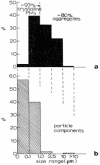


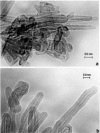
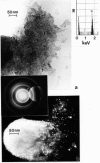
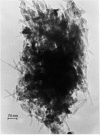
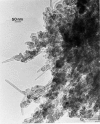
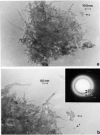
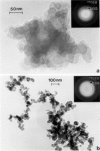


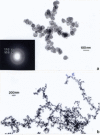
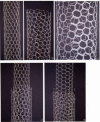
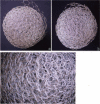
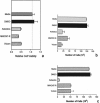

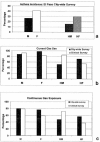
Similar articles
-
Cytotoxic responses and potential respiratory health effects of carbon and carbonaceous nanoparticulates in the Paso del Norte airshed environment.Int J Environ Res Public Health. 2008 Mar;5(1):12-25. doi: 10.3390/ijerph5010012. Int J Environ Res Public Health. 2008. PMID: 18441401 Free PMC article.
-
Cytotoxicity assessment of some carbon nanotubes and related carbon nanoparticle aggregates and the implications for anthropogenic carbon nanotube aggregates in the environment.Int J Environ Res Public Health. 2005 Apr;2(1):31-42. doi: 10.3390/ijerph2005010031. Int J Environ Res Public Health. 2005. PMID: 16705799 Free PMC article.
-
Characterization of nanostructure phenomena in airborne particulate aggregates and their potential for respiratory health effects.J Mater Sci Mater Med. 2004 Mar;15(3):237-47. doi: 10.1023/b:jmsm.0000015483.06136.68. J Mater Sci Mater Med. 2004. PMID: 15334995
-
A review of carbon nanotube toxicity and assessment of potential occupational and environmental health risks.Crit Rev Toxicol. 2006 Mar;36(3):189-217. doi: 10.1080/10408440600570233. Crit Rev Toxicol. 2006. PMID: 16686422 Review.
-
Health effects of carbon-containing particulate matter: focus on sources and recent research program results.Crit Rev Toxicol. 2016 Feb;46(2):97-137. doi: 10.3109/10408444.2015.1107024. Epub 2015 Dec 4. Crit Rev Toxicol. 2016. PMID: 26635181 Review.
Cited by
-
Development and characterization of an exposure platform suitable for physico-chemical, morphological and toxicological characterization of printer-emitted particles (PEPs).Inhal Toxicol. 2014 Jun;26(7):400-8. doi: 10.3109/08958378.2014.908987. Inhal Toxicol. 2014. PMID: 24862974 Free PMC article.
-
The value of using seasonality and meteorological variables to model intra-urban PM2.5 variation.Atmos Environ (1994). 2018 Jun;182:1-8. doi: 10.1016/j.atmosenv.2018.03.007. Epub 2018 Mar 8. Atmos Environ (1994). 2018. PMID: 30288136 Free PMC article.
-
Air pollution as an early determinant of COPD.Eur Respir Rev. 2022 Aug 10;31(165):220059. doi: 10.1183/16000617.0059-2022. Print 2022 Sep 30. Eur Respir Rev. 2022. PMID: 35948393 Free PMC article. Review.
-
Cytotoxicity and reactive oxygen species generation from aggregated carbon and carbonaceous nanoparticulate materials.Int J Nanomedicine. 2008;3(1):83-94. Int J Nanomedicine. 2008. PMID: 18488419 Free PMC article.
-
Metabolic Abnormalities of Erythrocytes as a Risk Factor for Alzheimer's Disease.Front Neurosci. 2018 Jan 5;11:728. doi: 10.3389/fnins.2017.00728. eCollection 2017. Front Neurosci. 2018. PMID: 29354027 Free PMC article. Review.
References
-
- D’Amato G. Urban air pollution and plant-derived respiratory allergy. Clin. and Exper. Allergy. 2000;30:628–636. - PubMed
-
- Salvi SS, Holgate ST. Is diesel exhaust a cause for increasing allergies? Clin. and Exper. Allergy. 1999;29(9):1187–1194. - PubMed
-
- Zhiqiang Q, Siegmann K, Keller A, Matter U, Scherrer L, Siegmann HC. Nanoparticle air pollution in major cities and its origin. Atmos. Environ. 2000;34:443–451.
-
- Renwick LC, Donaldson K, Clouter A. Impairment of alveolar macrophage/phagocytosis by ultrafine particles. Toxicol. and Appl. Pharmacol. 2001;172:119–127. - PubMed
-
- Samet JM, Dominici F, Curriero FC, Coursac I, Zeger SC. Fine particulate air pollution and mortality in 20 U.S. cities, 1987–1994. N. Eng. J. of Med. 2000;343(24):1742–1749. - PubMed
Publication types
MeSH terms
Substances
Grants and funding
LinkOut - more resources
Full Text Sources
